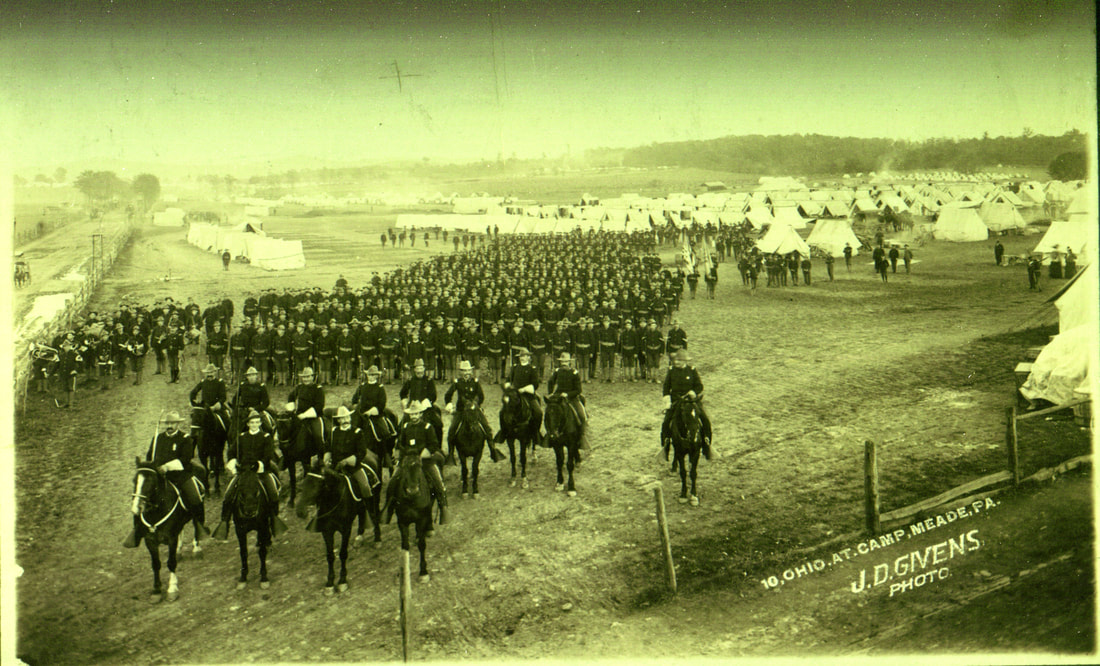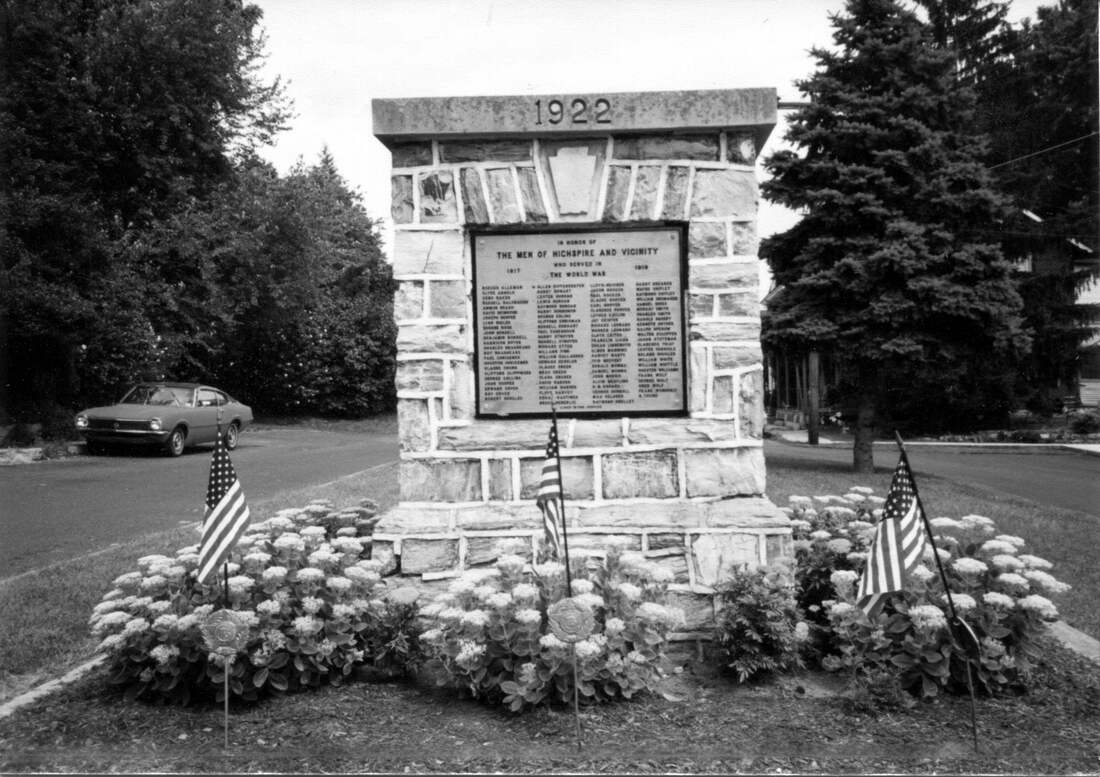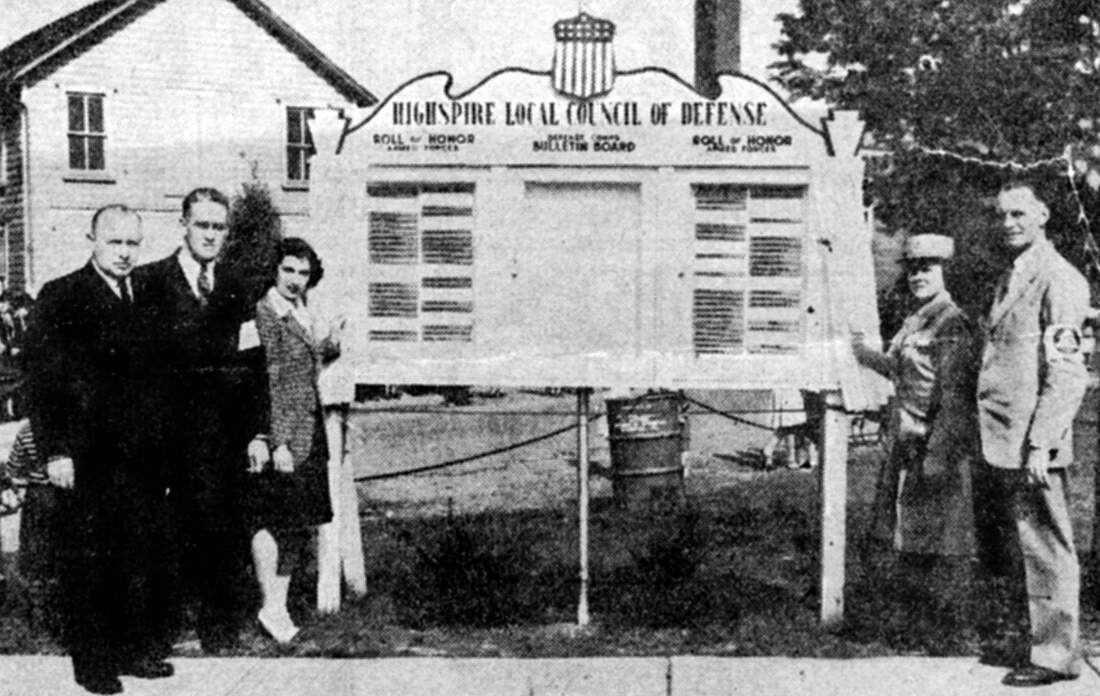WAR
Highspire was born during wartime, the War of 1812. The month that Berentz and Dochterman bought the first 15 acres of land for Highspire, December 1813, coincided with several battles in Upstate New York, near Niagara Falls and Buffalo. But that conflict between the United States and Great Britain was fought primarily along the coasts, at sea and along the Canadian border. It had little impact in the growing interior regions of Pennsylvania.
Summer 1863 was a time of great anxiety, even panic, for Highspire residents and all of Central Pennsylvania. In early June, Gen. Robert E. Lee’s Army of Northern Virginia began to move north into Pennsylvania. Word spread quickly, and area residents began to take precautionary measures such as hiding or burying their valuables. Gov. Andrew Curtain issued a call for additional troops. Confederate Gen. Richard Ewell’s II Corps was headed up the Cumberland Valley toward Harrisburg, and captured Mechanicsburg on June 28. During that same day, the 27th Pennsylvania Emergency Militia destroyed the Columbia-Wrightsville Bridge to keep Confederate Gen. John B. Gordon’s troops from crossing. Confederate attempts to cross the Susquehanna River were abandoned when Gen. Lee ordered his Army to converge on Gettysburg.
The call for emergency troops to repel the invasion went beyond Pennsylvania. One of the units mobilized was the 68th Infantry Regiment, New York National Guard from Chautauqua County, NY. They were sent to Harrisburg on June 25, 1863, to serve for 30 days with the 5th Brigade, 1st Division, Department Susquehanna. There was concern that the Confederate Army would try to cross the Susquehanna south of Harrisburg, so the 68th was deployed to Highspire from June 30 to July 4. In the regimental “History of the Thirty Days Campaign,” S.W. Lewis stated that “Highspire may appropriately be termed the Soldier’s Paradise.”
The Battle of Gettysburg turned the tide of the war in favor of the Union forces. There would be future cavalry raids, such as the burning of Chambersburg in July 1864, but Lee’s Army of Northern Virginia would never mount another massive invasion threatening the communities of Dauphin County.
The call for emergency troops to repel the invasion went beyond Pennsylvania. One of the units mobilized was the 68th Infantry Regiment, New York National Guard from Chautauqua County, NY. They were sent to Harrisburg on June 25, 1863, to serve for 30 days with the 5th Brigade, 1st Division, Department Susquehanna. There was concern that the Confederate Army would try to cross the Susquehanna south of Harrisburg, so the 68th was deployed to Highspire from June 30 to July 4. In the regimental “History of the Thirty Days Campaign,” S.W. Lewis stated that “Highspire may appropriately be termed the Soldier’s Paradise.”
The Battle of Gettysburg turned the tide of the war in favor of the Union forces. There would be future cavalry raids, such as the burning of Chambersburg in July 1864, but Lee’s Army of Northern Virginia would never mount another massive invasion threatening the communities of Dauphin County.
The next war to have a major impact on Highspire was the Spanish-American War in 1898. Camp Meade was established in Lower Swatara Township on Aug. 24, 1898. It occupied a large area between Highspire and Middletown, and extended north to Fulling Mill Road. The camp was established as a replacement for Camp Alger near Falls Church, VA. Camp Alger had a limited water supply, with barely enough water for drinking and cooking for the 22,000 men of the Second Army Corps stationed there. The move to Camp Meade also was designed to reduce the severity of a typhoid fever epidemic. The water at Camp Meade was supplied by artesian wells and was ample for bathing. The sanitary facilities and hospitals were excellent for a tent encampment.
This photo shows the 10th Ohio Volunteer Infantry at Camp Meade. The unit consisting of 42 officers and 1,280 enlisted men was mustered in between July 1 and July 7, 1898, in Columbus, Ohio. They arrived at Camp Meade on Aug. 20. They were assigned to the First Brigade,
Third Division of the Second Army Corps.
Third Division of the Second Army Corps.
The camp soon was occupied by the Second Army Corps, and President William McKinley inspected it on Aug. 27, 1898. For a short time in 1898, the little town of Highspire — with a population of not more than 1,500 — was neighbor to a major military post with all the problems and issues that come with it. For the short period of Camp Meade’s existence, Highspire must have been a much different place. The trolley and the railroad station would have been packed on weekends with young soldiers going to Harrisburg and points more distant. The customers in stores and taverns would have swelled far beyond peacetime levels, and the little village where everyone knew everyone else would have seen many strangers.
But Camp Meade had a very short existence. Even though the Treaty of Paris was not signed until Dec. 10, 1898, hostilities ended on Aug. 12, before Camp Meade was opened. Camp Meade was abandoned in November. Units were demobilized or reassigned to posts in the south. The camp was temporarily reopened from April to June 1899 to muster out volunteer units, and several new volunteer regiments recruited for the Philippine-American War were assembled there between July and November 1899.
But Camp Meade had a very short existence. Even though the Treaty of Paris was not signed until Dec. 10, 1898, hostilities ended on Aug. 12, before Camp Meade was opened. Camp Meade was abandoned in November. Units were demobilized or reassigned to posts in the south. The camp was temporarily reopened from April to June 1899 to muster out volunteer units, and several new volunteer regiments recruited for the Philippine-American War were assembled there between July and November 1899.
The year of Highspire’s Centennial, 1914, saw the start of the next conflict that affected many Highspire residents. The Great War — or as it later became known, the First World War or World War I — started on July 28, 1914. The United States at first resisted involvement in what was initially called the European War. But after renewed submarine attacks on shipping by the Germans, and after much debate in Congress, the United States finally entered the war on April 6, 1917, on the side of the Allies.
When the United States entered the war it was ill-prepared, but it quickly mobilized. A Selective Service Act was passed by Congress and 2.8 million men were drafted into service to support a total military that grew to four million. By summer 1918, the United States was sending ten thousand men a day to France to join the fight. One of the mobilization initiatives was the creation of a supply and maintenance depot for Army Signal Corps aircraft along the Susquehanna River between Highspire and Middletown, on the southern edge of what had 20 years before been Camp Meade. This installation would have a major influence on Highspire for the next 50 years.
When the United States entered the war it was ill-prepared, but it quickly mobilized. A Selective Service Act was passed by Congress and 2.8 million men were drafted into service to support a total military that grew to four million. By summer 1918, the United States was sending ten thousand men a day to France to join the fight. One of the mobilization initiatives was the creation of a supply and maintenance depot for Army Signal Corps aircraft along the Susquehanna River between Highspire and Middletown, on the southern edge of what had 20 years before been Camp Meade. This installation would have a major influence on Highspire for the next 50 years.
These are some of the Highspire soldiers who served in the First World War. Their photo was taken during the welcome home celebration in October 1920.
Ninety-seven Highspire men served in the military during World War I. One soldier, Allen Diffenderfer, was killed in action. On Oct. 18 and 19, 1920, a celebration with special church services, a parade, a football game, a community sing, and a reception and banquet was held for the returning service men. They were given medals for their service. A few years later, funds were raised for a memorial to the veterans of The Great War. It was erected on Market Square, and consists of a native blue limestone shaft eight feet high with a bronze tablet with the names of the 97 Highspire veterans. It was dedicated May 28, 1922. The ceremony included music by the Highspire Band and a 100-voice school choir.
This is the memorial to the 97 Highspire residents who served during the First World War. It is on the east side of Market Square, at the intersection of Market and Roop streets.
In the years immediately after World War I, it sometimes was referred to as the War to End All Wars. That optimism was short-lived. In just two short decades, war would again break out in Europe and in the Far East. The Japanese bombing of Pearl Harbor on Dec. 7, 1941, would again draw a reluctant nation into a worldwide war. The war effort in World War II dwarfed that of the First World War. More than 16 million men and women served in the military. Of those, 290,000 were killed in action and 670,000 were wounded. We have no exact count of the Highspire residents who served in World War II. But based on an American Legion estimate of eligible members from both world wars, the number is approximately 280. Of those, four died. One airman, Staff Sgt. William S. Byers, was taken prisoner by the Germans in April 1944, and was liberated and repatriated in May 1945.
The Second World War had as profound an effect on Highspire as it did the whole nation. Daily routines on the home front were impacted more than in any previous conflict. There were price controls and rationing. Civil Defense measures and drills became commonplace. Income taxes were levied on almost everyone, not just the top ten percent of earners, as before the war. By 1943 there were severe manpower shortages. Women became a larger part of the civilian workforce. Many stores converted from counter service to self-service to eliminate clerks. People migrated to industrial centers to support the war effort. Highspire grew because it was between two major war industries: Bethlehem Steel and the Aviation Depot at Olmsted Air Field.
The Second World War had as profound an effect on Highspire as it did the whole nation. Daily routines on the home front were impacted more than in any previous conflict. There were price controls and rationing. Civil Defense measures and drills became commonplace. Income taxes were levied on almost everyone, not just the top ten percent of earners, as before the war. By 1943 there were severe manpower shortages. Women became a larger part of the civilian workforce. Many stores converted from counter service to self-service to eliminate clerks. People migrated to industrial centers to support the war effort. Highspire grew because it was between two major war industries: Bethlehem Steel and the Aviation Depot at Olmsted Air Field.
The Servicemen’s Board on the lawn of the Highspire State Bank was dedicated Oct. 11, 1942. At that time, 68 men and two women were serving in the military. The board was erected by the Highspire Defense Council. Pictured left to right are: the Rev. W.E. Deibler , J.L. Weidenhammer,
Kathleen Zeller, Lt. Elizabeth Warren, and Maj. Elmer Manning.
Approximately 1,000 people attended the dedication.
Kathleen Zeller, Lt. Elizabeth Warren, and Maj. Elmer Manning.
Approximately 1,000 people attended the dedication.
Housing shortages quickly appeared around those military installations and industrial centers supporting the war effort. Like military installations around the country, the Middletown Air Depot greatly expanded during World War II. Housing for the new civilian employees was a problem. The Farm Security Administration and the Federal Housing Authority built temporary housing behind the East End School, between Eshleman Street and the reservoir. The school building, which had been closed in 1940, was used as an administrative office. The housing complex consisted of 70 apartments and 185 small-room units. The buildings were razed after the war.
Temporary housing for civilian employees of the Middletown Air Depot was built on the north side of Eshleman Street near the East End School in 1942. The buildings were razed after World War II.
The former canal bed and reservoir are visible at the top of the photo.
The former canal bed and reservoir are visible at the top of the photo.
While there have been no declared wars since World War II, the United States has been involved in 14 major military operations over the past 69 years. The first, and the one with the most intense combat and largest opposing forces, was the Korean War, from June 1950 to July 1953. The United States suffered more than 36,000 military deaths, including two men from Highspire. The most deaths of any conflict since World War II occurred in the 12-year Vietnam War. More than 58,000 service members died in that conflict. The United States has been involved in war continuously since the terrorist attacks of Sept. 11, 2001. First in Afghanistan, a war that now holds the record for the longest conflict in U.S. history; and the Iraq War from March 2003 to December 2011. One Highspire resident died in Iraq.
On Memorial Day, May 30, 1858, Highspire dedicated a new memorial at Memorial Park to all Highspire men and women who served their country. The memorial is dedicated to all those who paid the supreme sacrifice. They are: Alan F. Diffenderfer, WW I; Edward L. Arnold, Herbert C. Walmer, George E. Worrall and Rex A. Byers, WW II; William E. Bonawitz and Donald F. Roth, Korean War; and James M. Yohn, Iraq.
On Memorial Day, May 30, 1858, Highspire dedicated a new memorial at Memorial Park to all Highspire men and women who served their country. The memorial is dedicated to all those who paid the supreme sacrifice. They are: Alan F. Diffenderfer, WW I; Edward L. Arnold, Herbert C. Walmer, George E. Worrall and Rex A. Byers, WW II; William E. Bonawitz and Donald F. Roth, Korean War; and James M. Yohn, Iraq.
The Highspire War Memorial at Memorial Park honoring all Highspire veterans was dedicated on Memorial Day 1958. It lists all those who died in military conflicts.






